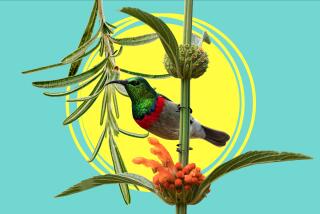Gardenias Need Sun to Thrive
- Share via
Are you convinced that the most popular gardenia is named ‘Mystery’ because it’s such a puzzling plant to grow? Tempted by the heady high-school corsage fragrance, a lot of people try, only to give up when plant after plant yellows and dies.
Yet Herbert Kelly, who grows 25 varieties at his nursery in the Central Valley town of Sanger, thinks they’re “relatively easy to grow,” and it doesn’t take too much searching in most neighborhoods to find old, thriving, six-foot bushes covered in flowers.
So, why do some plants yellow and die while others thrive?
For one thing, “they need full sun,” said Kelly, even in the sizzling Central Valley where his nursery is located. “I don’t know where nurserymen got the idea that they grow in shade, yet I have many customers tell me that’s where they were told to plant their gardenia.”
Gardenias love and need heat, especially at their feet, and except in the hottest climates, they can’t get it growing in the shade.
Conrad Skimina, retired research director at Monrovia Nursery Co., one of the largest wholesale growers, says they just do poorly when soil temperatures drop below 62 degrees.
That’s why they turn yellow in winter. Skimina says that they can’t take up iron from a chilly soil, so become chlorotic (leaves yellow between the veins). If they become too chlorotic, the leaves will never recover, no matter what you do, and they eventually fall off.
You can help emerging spring foliage by mixing ferrous sulfate or iron chelate into the top inch of soil, but even then, the soil has to be warm for the plant to make use of it. He suggests doing this only in spring and summer.
If you really want to make a difference, it’s best done at planting time, so (are you ready to try again?) be prepared to try and make our naturally alkaline soils acidic.
Gardenias like and need an acid soil. A pH of 5.5 is about right. To do this, mix soil sulfur (available at nurseries) into the soil before planting.
And, mix in an organic amendment. This will also help improve the drainage of the soil since gardenias don’t like heavy clay soils. Several inches mixed into the top foot of soil should do it.
Skimina likes sphagnum peat moss (not sedge peat) because it is the most acidic amendment. Just be careful to not let it dry out before adding it to the soil or you will have a frustrating time trying to re-wet it (with regular watering it is unlikely to dry out once in the soil).
(If you buy it dry, soak the loose peat for several days in a plastic garbage can to wet it.)
You can also use ground bark-type amendments, but Skimina doesn’t recommend those that use redwood bark since they may impede growth.
Gardenias need what Kelly calls “regular watering,” which means not too much, nor too little. They don’t tolerate going dry.
Fertilize several times during the growing season, starting in spring, and each time use an acid-type fertilizer (usually sold for azaleas and camellias) that contains an ammonium type of nitrogen, such as ammonium sulfate or ammonium nitrate or urea. This will also help acidify the soil.
Kelly also suggests a thick mulch of ground fir bark (not redwood), or something similar, to keep the soil a little cooler in summer and warmer in winter in inland areas.
In a nutshell, then, this is what gardenias need: Full sun, acid soil, periodic fertilizing with an acid-type fertilizer, regular watering and a healthy mulch. That doesn’t sound too difficult, does it?
‘Mystery,’ growing to 5- or 6-feet tall by about 3-feet wide, with glossy green leaves and creamy-white double flowers, may be the most popular gardenia, but there are others.
‘August Beauty’ is similar (and as tall), but it flowers a little earlier and a little later in the year, from May to November.
‘First Love’ is a new variety from Monrovia Nursery that should be available at your local garden supplier. It too is similar to ‘Mystery’ but larger in all its parts with bigger flowers and leaves.
The flowers are probably the same as those grown in Hawaii for use in leis (which is where this variety originated), and they are up to four inches across. The foliage is a deeper green and Audrey Teasdale, Monrovia’s botanist, says they have less of a tendency to yellow.
Watch for a new single-flowered variety named ‘Daisy,’ coming from Hines Wholesale Nursery in the near future. It makes a compact three-foot ball with dark green leaves and fragrant, five-petaled blossoms.






